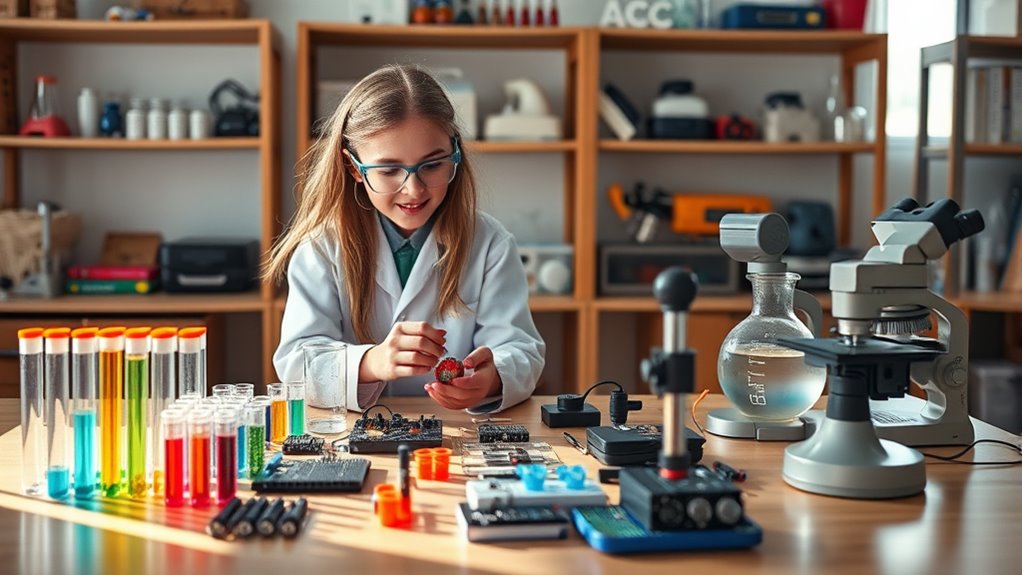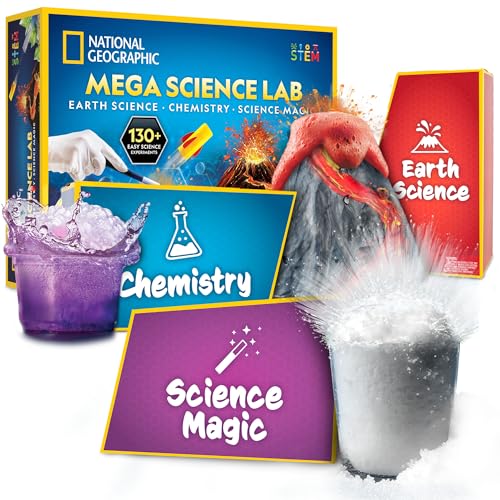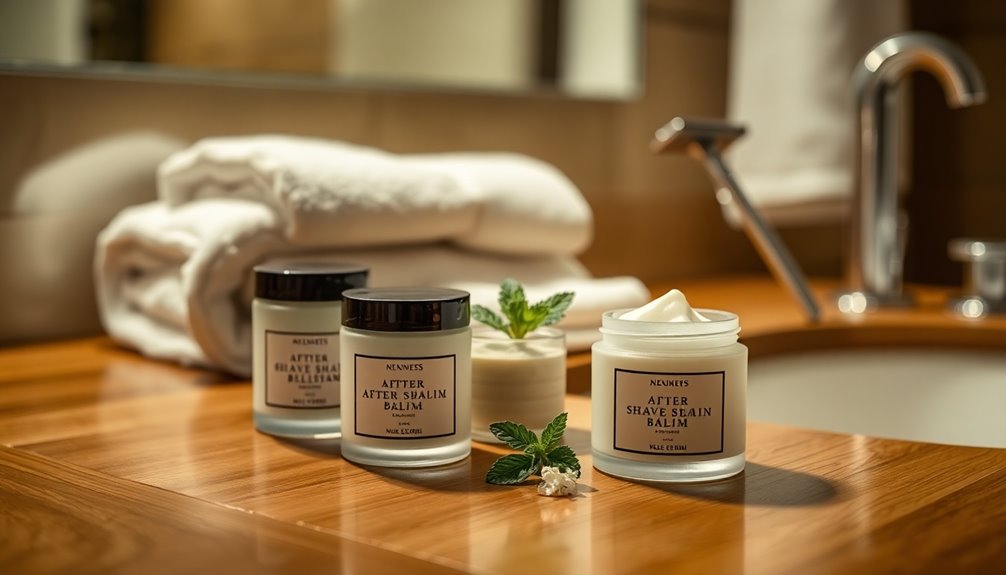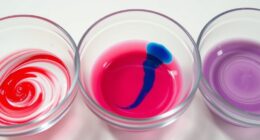If you’re looking for the best science kits for teenagers in 2025, I’ve got you covered. From hands-on experiments like volcanoes, crystals, and water purification to robotics and electronics projects, these kits spark curiosity and build STEM skills. Brands like Thames & Kosmos, Playz, and 4M offer engaging options for ages 8-16+. Keep exploring to discover the top picks that inspire young minds and foster a love for science.
Key Takeaways
- Highlights top-rated science kits that combine fun and education for teenagers interested in STEM.
- Emphasizes kits offering diverse experiments in chemistry, physics, robotics, and environmental science.
- Focuses on engaging, hands-on kits suitable for ages 8-16+ to foster curiosity and critical thinking.
- Includes features like detailed instructions, online resources, and award-winning quality.
- Aims to inspire independent exploration and practical understanding of scientific principles in 2025.
Thames & Kosmos Mega Cyborg Hand STEM Kit
If you’re a teenager interested in hands-on engineering, the Thames & Kosmos Mega Cyborg Hand STEM Kit is an excellent choice because it lets you build a giant, wearable robotic hand that operates without motors or batteries. Using air pressure, water, and manual effort, you can control the hand’s movements, including gripping and lifting objects. The hydraulic pistons make the fingers move smoothly and with force, and you can customize the joint angles for different tasks. With three configurations—right hand, left hand, or claw—it fits various hand sizes. This kit offers a fun, practical way to explore pneumatic and hydraulic systems firsthand.
Best For: teenagers interested in hands-on engineering projects and learning about pneumatic and hydraulic systems through building a wearable robotic hand.
Pros:
- Teaches fundamental principles of pneumatics and hydraulics with a practical, hands-on approach
- No motors or batteries required, making it easy to operate and environmentally friendly
- Customizable finger joints and three configurations allow for versatility and realistic movement
Cons:
- May require adult supervision for younger users due to small parts and assembly complexity
- Limited to pneumatic and hydraulic mechanisms, which may not reflect all types of robotic systems
- Potentially fragile components if not assembled properly or handled with care
Playz Mega Kaboom! Science Experiments Kit for Kids
Looking for a science kit that sparks curiosity and excitement in teenagers? The Playz Mega Kaboom! Science Experiments Kit is perfect for kids aged 8-12, offering over 150 explosive and engaging experiments. From balloon rockets to fizzy bombs and color explosions, it makes chemistry thrilling and accessible. The kit includes a detailed lab guide with clear instructions and fun facts, ensuring safe, step-by-step learning. It’s ideal for family activities or gift-giving, providing both entertainment and education. With high-quality materials and a focus on safety, this kit turns science into an explosive adventure that fuels curiosity and creativity in young learners.
Best For: parents, teachers, and children aged 8-12 who want an engaging, safe, and educational science kit that sparks curiosity and creativity through explosive chemistry experiments.
Pros:
- Offers over 150 fun and educational experiments that introduce kids to chemistry concepts in an exciting way
- Comes with a comprehensive, easy-to-follow lab guide filled with fun facts and step-by-step instructions
- Made with high-quality materials ensuring safety, durability, and lasting entertainment
Cons:
- May require adult supervision for some experiments to ensure safety
- The abundance of experiments might be overwhelming for some children without guided structure
- The kit’s contents could be limited for continuous use without additional supplies or kits
4M Clean Water Science Educational STEM Toy
The 4M Clean Water Science Educational STEM Toy is an excellent choice for young science enthusiasts aged 8 and up who are enthusiastic to explore environmental science and water treatment. I love how it offers hands-on experiments like building desalination units and filtering dirty water, making complex concepts accessible. The kit includes filters, active carbon, sand, and tools, along with clear instructions. It encourages problem-solving and environmental awareness while being fun and educational. Teens will enjoy testing different water purification methods and learning about chemistry and conservation through engaging activities. It’s a practical, inspiring kit that fosters curiosity and scientific thinking in a meaningful way.
Best For: young science enthusiasts aged 8 and up interested in exploring environmental science, water treatment, and STEM activities through hands-on experiments.
Pros:
- Engages children with practical, educational water purification and desalination experiments
- Includes comprehensive components and clear instructions suitable for beginners
- Promotes problem-solving, environmental awareness, and scientific thinking in a fun way
Cons:
- Small parts may pose a choking hazard or be difficult for younger children to handle without supervision
- Some users report that complex instructions could be challenging for children under 11 without adult assistance
- Limited to water filtration and desalination experiments, which might require additional tools for advanced projects
4M Crystal Growing Science Kit
The 4M Crystal Growing Science Kit stands out as an excellent choice for curious teens enthusiastic to explore chemistry and geology through hands-on experiments. I love how it includes everything needed to grow seven different crystals, from colorful seeds to display cases, making science both fun and tangible. The step-by-step instructions are clear, guiding users through dissolving, waiting, and observing crystal growth over several days. Watching crystals form overnight is truly satisfying, and the variety of shapes and colors sparks creativity. It’s a compact, educational kit that promotes patience, scientific inquiry, and curiosity, perfect for young explorers eager to understand the science behind crystals.
Best For: curious teens and young science enthusiasts eager to explore chemistry and geology through hands-on crystal growing experiments.
Pros:
- Includes all necessary materials for seven different crystal experiments, encouraging comprehensive learning.
- Clear, step-by-step instructions make the process easy and educational for beginners.
- Promotes patience, curiosity, and scientific inquiry while producing visually stunning, colorful crystals.
Cons:
- Some users may experience incomplete or less impressive crystal growth if instructions are not followed precisely.
- Crystals can take several days to fully develop, requiring patience and supervision.
- Occasional reports of smaller-than-expected crystals or issues with the quality of geodes.
UNGLINGA 150 Experiments Science Kits for Kids
If you’re searching for a complete science kit that challenges teenagers and sparks their curiosity, the UNGLINGA 150 Experiments Science Kit is an excellent choice. It offers 150 hands-on STEM activities, covering chemistry, physics, earth sciences, and more. The kit includes a detailed experiment book, high-quality lab tools, and kid-friendly materials, making it easy to perform experiments like volcano eruptions and surface tension tests. Designed to be durable and colorful, it encourages independent learning and creativity. Perfect for home, school, or travel, this kit keeps kids engaged for hours while fostering scientific thinking and problem-solving skills.
Best For: Parents, teachers, and guardians seeking a comprehensive, engaging science kit to inspire curiosity and scientific learning in children aged 8 and above.
Pros:
- Includes 150 hands-on experiments covering diverse STEM topics for extensive educational fun.
- Comes with a detailed experiment book, high-quality tools, and kid-friendly materials, facilitating independent learning.
- Promotes creativity, problem-solving, and scientific thinking through engaging, easy-to-follow activities.
Cons:
- Some users have reported missing items such as measuring cups or pigments, affecting certain experiments.
- Packaging issues during shipping have occasionally led to damaged components or incomplete sets.
- Instructions are only available in English, which may limit usability for non-English speaking users.
National Geographic Mega Science Lab Kit for Kids
Designed for curious young explorers, the National Geographic Mega Science Lab Kit for Kids offers over 130 hands-on experiments that make learning science both fun and engaging. With 45 experiments covering Earth science, chemistry, and magic, there’s plenty to discover. You can build volcanoes, grow glow-in-the-dark crystals, and dig up real fossils. The chemistry activities include making gooey worms and launching gas rockets. Plus, the magic science tricks, like changing water colors and catching bubbles, add a fun twist. Award-winning and supported by a dedicated U.S.-based team, this kit inspires creativity, curiosity, and a passion for science in young learners.
Best For: young curious explorers and aspiring scientists eager to learn and experiment with Earth science, chemistry, and magic tricks in a fun, educational way.
Pros:
- Over 130 hands-on experiments to keep children engaged and learning for hours
- Includes a variety of projects across Earth science, chemistry, and magic to foster diverse scientific interests
- Award-winning Blue Marble brand with dedicated U.S.-based support ensures quality and reliable assistance
Cons:
- The large number of experiments may be overwhelming for some children to complete all at once
- Requires adult supervision and household items for many activities, which may not be readily available
- Some experiments may need extra safety precautions or materials not included in the kit
“Hydrobot Arm Kit”, Hydraulic Kit, STEM Building Toy for Kids 12+
For teens interested in robotics and mechanical engineering, the Hydrobot Arm Kit offers an engaging hands-on experience that combines learning with fun. Powered by water hydraulics, it allows you to assemble a multi-axis robotic arm with realistic movement, including rotation, gripping, and wrist functions. The detailed instructions and precise parts challenge your mechanical skills, making assembly rewarding. Although it requires patience and some adult supervision, the kit provides a great introduction to engineering concepts, green energy, and robotics without batteries. With sturdy components and a focus on educational growth, it’s an excellent way to develop problem-solving skills while having fun building a functional hydraulic robot.
Best For: teens and older kids interested in robotics, mechanical engineering, and hands-on STEM learning who enjoy challenging assembly projects and exploring green-energy concepts.
Pros:
- Engages users in practical learning of robotics, hydraulics, and engineering principles.
- Promotes problem-solving, patience, and mechanical aptitude through detailed assembly.
- Uses water hydraulics, eliminating the need for batteries and fostering environmentally friendly energy understanding.
Cons:
- Assembly can be time-consuming and may require adult supervision and mechanical experience.
- Some parts and hydraulic lines may become loose or detach over time, needing maintenance.
- Packaging quality has been noted as less durable, with occasional damage upon delivery.
Thames & Kosmos Chemistry Chem C500 Science Kit
Looking for a science kit that offers an authentic chemistry lab experience for teenagers just starting out? The Thames & Kosmos Chemistry Chem C500 Science Kit is perfect. It includes 28 guided experiments, a colorful manual, and real chemicals, glassware, test tubes, and a dropper. Designed for ages 10-15, it teaches fundamental concepts like reactions between solids, liquids, gases, acids, and bases, with fun effects like fizzing and invisible ink. Though small and requiring extra household supplies, it provides a genuine lab experience and encourages curiosity. As a Parents’ Choice Silver Award winner, it’s a great way to introduce teens to chemistry safely and engagingly.
Best For: teenagers aged 10-15 who are interested in experiencing authentic chemistry experiments and developing foundational scientific skills in a safe, engaging way.
Pros:
- Includes real chemicals, glassware, and test tubes for a genuine lab experience
- Offers 28 guided experiments with clear instructions and explanations
- Award-winning design that stimulates curiosity and foundational chemistry learning
Cons:
- Small quantities of chemicals require additional household supplies for extended experiments
- Manual may arrive damaged, necessitating online access to instructions
- Limited scope compared to larger, more comprehensive chemistry kits
4M Kidzlabs Anti Gravity Magnetic Levitation Science Kit
If you’re curious about how magnetic forces can make objects float, the 4M Kidzlabs Anti Gravity Magnetic Levitation Science Kit offers an engaging hands-on experience perfect for curious teens. This kit teaches about magnetic attraction and repulsion through experiments like floating a pencil, levitating a screw, and building a maglev device. It includes durable parts, quality magnets, and clear instructions for multiple uses, fostering creativity and understanding of magnetic principles. Ideal for ages 8 and up, it encourages experimentation, critical thinking, and fun learning. Many users find it durable and educational, making it a great gift for young science enthusiasts interested in physics and magnetism.
Best For: young science enthusiasts aged 8 and up, especially those interested in physics, magnetism, and hands-on experiments to foster curiosity and critical thinking.
Pros:
- Includes durable, high-quality magnets and plastic parts suitable for multiple experiments
- Offers engaging, hands-on activities that effectively teach magnetic attraction, repulsion, and levitation principles
- Provides clear instructions and materials that promote creativity and repeated use, making learning fun and interactive
Cons:
- Some plastic components may be fragile or difficult to manipulate for younger children
- Instructions printed in small font can be challenging for easy readability
- Parts may not fit perfectly together at times, requiring patience and adult assistance
ELEGOO UNO R3 Robot Car Kit V4 for Arduino STEM Robotics for Kids 8-16
Ever wondered how to turn a curious teen’s interest in robotics into real hands-on experience? The ELEGOO UNO R3 Robot Car Kit V4 is perfect for that. Designed for ages 8-16, it offers an extensive STEM learning experience through building and coding. With 24 modules like obstacle avoidance, line tracing, and remote control, it covers key robotics concepts. The easy-to-assemble modules with clear tutorials make it accessible for beginners, while compatibility with Android and iOS devices adds versatility. This kit not only sparks creativity but also builds essential engineering skills, making it an ideal gift for young tech enthusiasts enthusiastic to explore robotics and programming.
Best For: young learners aged 8-16 interested in hands-on STEM education, robotics, and programming.
Pros:
- Comprehensive kit with 24 modules including obstacle avoidance, line tracing, and remote control for diverse learning experiences
- Easy-to-assemble modules with XH2.54 ports and clear HD tutorials suitable for beginners
- Compatibility with Android and iOS devices offers versatile remote control options
Cons:
- Basic electronic knowledge recommended, which may require guidance for complete beginners
- Some advanced features might need prior experience to fully utilize
- The kit’s complexity could be overwhelming for very young children without adult supervision
UNGILINGA 70 Lab Experiments Science Kits for Kids Educational Scientist Toys
UNGILINGA’s 70 Lab Experiments Science Kit is perfect for curious teenagers enthusiastic to explore STEM concepts hands-on. I love how this kit offers a variety of engaging experiments like erupting volcanoes, crystal growing, balloon rockets, and fruit circuits, providing hours of educational fun. All ingredients are child-safe, and the step-by-step manuals make complex concepts easy to understand. It promotes critical thinking, problem-solving, and teamwork, making science accessible and exciting. Whether at home or in the classroom, this kit encourages independent experimentation and inspires a lasting appreciation for science, making it an excellent choice for young aspiring scientists.
Best For: curious children aged 8 and above, parents, teachers, and young aspiring scientists seeking a comprehensive, engaging STEM learning experience.
Pros:
- Offers 70 varied experiments that promote hands-on learning and critical thinking
- Includes clear, illustrated manuals suitable for independent or guided exploration
- Promotes teamwork, safety, and scientific curiosity for educational growth
Cons:
- Some experiments may require additional household items like lemons or flour
- Instructions can sometimes be vague or confusing for first-time users
- Certain components like beakers need careful hand-washing to prevent damage
Pathfinders STEM Kits – Leonardo da Vinci Catapult kit
The Pathfinders STEM Kit – Leonardo da Vinci Catapult is an excellent choice for curious children aged 8 and up who enjoy hands-on building and exploring physics. This kit offers a real wooden model inspired by da Vinci’s siege engine, taking about an hour to assemble. Once built, it’s a functional launcher that can fire soft projectiles over 15 feet, demonstrating principles like tension, force, and motion. Made from eco-friendly, non-toxic wood, the kit emphasizes safety and durability. It’s perfect for school projects, family activities, or STEM exploration, encouraging kids to learn through creative experimentation and engineering challenges.
Best For: curious children aged 8 and up interested in hands-on STEM activities, engineering, and physics exploration.
Pros:
- Engages children in educational, interactive building and experimentation
- Made from eco-friendly, durable, and non-toxic wood materials
- Fosters parent-child bonding through collaborative assembly and play
Cons:
- Assembly may be challenging for younger children without adult help
- Some users report minor frustrations with piece fitting and sanding
- Requires additional glue for a tighter fit and optimal performance
STEM Projects for Kids & Adults Build Bluetooth Speaker DIY Electronics Kit
If you’re looking for a hands-on project that makes learning electronics fun and accessible, the Build Bluetooth Speaker DIY Electronics Kit is an excellent choice for teenagers aged 10 and up. This kit includes wooden components, a Bluetooth board, and electronic parts, allowing users to assemble a portable speaker without soldering. It’s simple to put together, taking about 30 minutes with clear instructions and basic tools. The kit promotes problem-solving, curiosity, and understanding of circuits and speaker mechanics. Its stylish design and practical functionality make it a great educational gift for families, students, or anyone interested in exploring electronics through a rewarding DIY experience.
Best For: hobbyists, kids, and adults aged 10 and up interested in hands-on electronics projects and learning about speaker mechanics.
Pros:
- Easy to assemble with no soldering required, making it suitable for beginners.
- Promotes experiential learning, problem-solving, and curiosity about circuits and electronics.
- Stylish design with practical functionality, serving as a fun educational gift or family activity.
Cons:
- Powered by 4 AA batteries, which are not included, possibly requiring additional purchase.
- Sound quality is good but not premium, which may not satisfy audiophiles.
- Assembly time is around 30 minutes, which might be too long for very young children or impatient users.
Playz Edible Candy Making Science Kit for Kids
For parents seeking a fun yet educational activity for kids aged 8-12, the Playz Edible Candy Making Science Kit stands out as an engaging choice. It offers 40 experiments, including chocolates, jelly candies, lollipops, and rock candy, that teach STEM concepts through hands-on cooking. The kit includes over 21 tools, ingredients, a detailed 32-page lab guide, and colorful instructions, making science accessible and fun. Kids can explore dissolving, chemical reactions, and measurements while creating tasty treats. It’s a popular gift that combines creativity and learning, encouraging problem-solving and patience while making edible candies. Plus, the positive reviews confirm its educational and entertainment value.
Best For: parents and educators seeking a fun, educational, and hands-on STEM activity to engage children aged 8-12 in edible candy making and science exploration.
Pros:
- Promotes STEM learning through interactive experiments with candies like chocolates and lollipops.
- Includes over 21 tools and a detailed 32-page lab guide, making it easy for kids to follow along.
- Encourages creativity, problem-solving, and patience while making edible treats in a safe, mess-controlled environment.
Cons:
- Some candies may lack flavor or have a grainy or bitter texture, requiring additional ingredients or adjustments.
- The kit does not include all supplies like chocolate melting chips or food coloring, leading to extra purchases.
- Final treats may not be very sweet or gourmet, as the focus is more on science and fun than on perfect confections.
Factors to Consider When Choosing Science Kits for Teenagers

When selecting a science kit for teenagers, I always check if it matches their age and skill level to keep things fun and challenging. I also consider the educational focus to guarantee it teaches useful concepts and skills. Most importantly, I look at safety precautions and material quality to make sure they can explore confidently and safely.
Age Appropriateness
Choosing the right science kit for teenagers means paying close attention to age appropriateness, ensuring the activities match their developmental stage and cognitive abilities. It is vital to select kits designed for ages 12 and up, so the complexity of experiments aligns with their critical thinking skills. Check that instructions are suitable for teenagers—challenging enough to keep them engaged but not too difficult to discourage them. Consider if the kit includes age-appropriate safety equipment and warnings, as older teens can handle more advanced tools and procedures. Additionally, look for kits that match their educational level and interests, providing a good balance of fun and learning. Proper age appropriateness ensures the experience is both safe and stimulating, fostering curiosity without causing frustration.
Educational Focus
Selecting a science kit that emphasizes core STEM principles helps teenagers build a strong foundation in science. I look for kits that cover physics, chemistry, biology, or engineering to guarantee a well-rounded learning experience. Detailed, age-appropriate guides are essential, as they support independent exploration while reinforcing key concepts. I also prioritize kits that incorporate real-world applications or advanced topics like robotics, environmental science, or electronics, which challenge and keep teens engaged. Critical thinking and problem-solving are crucial, so I choose kits that include experiments involving hypothesis testing, data analysis, and troubleshooting. Safety and accuracy are non-negotiable; authentic scientific tools and chemicals suitable for teens ensure a secure, educational environment. These factors help make science kits both educational and stimulating.
Skill Level Needed
Matching a science kit to a teen’s current skill level is essential for a positive and engaging learning experience. I recommend selecting kits that match their knowledge, with beginner options offering simple instructions and more advanced kits providing greater complexity. Check the age recommendations on the packaging to ensure the kit suits their developmental stage—most range from 8 to 16+ years. It’s important that the kit includes clear instructions and explanations aligned with their understanding, so they can learn independently and confidently. Additionally, choose kits that allow for experimentation beyond basic steps, encouraging critical thinking and problem-solving skills. This balance helps prevent frustration while providing just enough challenge to keep them motivated and curious.
Safety Precautions
When I pick out a science kit for a teen, safety has to be my top priority. I always check that the materials are non-toxic and suitable for their age group, so there’s no risk of harmful exposure. Clear safety instructions are essential, along with proper protective gear like goggles and gloves, to prevent accidents during experiments. I also verify that the experiments don’t involve hazardous chemicals or open flames without adult supervision. Age-appropriate warnings are a must to minimize risks from chemical reactions or delicate equipment. Additionally, I look for kits with safety certifications such as ASTM or CE markings, which ensure they meet strict safety standards. This way, I can confidently encourage curiosity without compromising safety.
Material Quality
Ensuring the materials in a science kit are of high quality makes a significant difference in safety and durability. I look for kits that use non-toxic, eco-friendly materials like FSC-certified wood, BPA-free plastics, and medical-grade chemicals to guarantee safe experiments and long-lasting components. Precise, well-made items such as glassware, metal tools, and sturdy parts help support accurate results and withstand frequent use. Material quality also impacts safety, especially when handling chemicals or electronics, reducing the risk of accidents. High-quality kits often feature clear instructions printed on durable paper or digital formats that resist wear over time. Investing in well-crafted materials means fewer broken parts and a more reliable, safe learning experience for teens enthusiastic to explore science.
Experiment Variety
A science kit that offers a wide variety of experiments keeps teenagers engaged and enthusiastic to explore different scientific fields. When choosing a kit, I look for one with over 100 experiments, as it provides extended enjoyment and helps teens discover their interests within STEM. The best kits include diverse types of experiments—hands-on projects, demonstrations, and real-world applications—that spark curiosity and motivation. It’s also important that the kit features different materials and techniques, encouraging skill development and a deeper understanding of scientific principles. A well-rounded selection challenges teens with various scenarios, fostering critical thinking and problem-solving. Overall, variety in experiments ensures continuous learning and keeps teenagers excited about science, making the experience both educational and fun.
Ease of Assembly
Choosing a science kit with a wide variety of experiments is great for keeping teenagers engaged, but it’s equally important to regard how easy it is to assemble. I look for kits with clear, step-by-step instructions that teens can follow on their own, reducing frustration. The best kits require minimal tools or complex procedures, making setup quick and stress-free. Pre-assembled components or parts that snap together easily are a huge plus, as they cut down on assembly time and eliminate the need for adult supervision. I also check if the kit minimizes small or fragile parts that could complicate the process or cause mishaps. Additionally, online tutorials or visual guides can make assembly more accessible, helping teens feel confident and independent as they build their experiments.
Budget Considerations
Budget considerations play a crucial role in selecting the right science kit for teenagers, as prices can range from under $20 to over $100. I recommend determining your budget early, as this influences the complexity and the number of materials included. Keep in mind that some kits may require extra household items or supplies to complete experiments, which can add to the overall cost. It’s essential to compare the price-to-educational value, ensuring the kit offers enough experiments and learning opportunities for its price. While more expensive kits typically feature durable materials and a wider variety of experiments, budget-friendly options can still be effective if they meet safety standards and include essential components. Balancing cost with quality ensures a meaningful and safe learning experience.
Frequently Asked Questions
How Safe Are These Science Kits for Teenage Use at Home?
These science kits are generally very safe for teenagers at home, especially when they come with clear instructions and safety guidelines. I always recommend supervising younger teens and making sure they wear protective gear like goggles and gloves. Most kits are designed with safety in mind, but it’s important to follow the instructions carefully. When used responsibly, they offer a fun and educational experience without unnecessary risks.
Can These Kits Be Used for Classroom Science Projects?
Absolutely, these science kits are perfect for classroom projects. I’ve seen how engaging they can be, encouraging hands-on learning and teamwork. While some kits are designed for individual exploration, many include experiments suitable for group work, fostering collaboration. Just ensure that the kits match your curriculum and safety standards, and they can considerably enhance understanding of scientific concepts while making learning fun for students.
Do These Kits Include All Necessary Tools and Instructions?
Yes, these science kits usually include all the necessary tools and detailed instructions. I find they’re designed to be user-friendly, so teens can confidently explore scientific concepts without needing extra supplies. Everything is typically packed in a neat, organized way, making it easy to follow each step. This way, young scientists can dive right in and enjoy hands-on learning without any hassle.
Are the Experiments Suitable for Beginners or Advanced Teenagers?
Absolutely, the experiments are designed to delight and challenge both beginners and advanced teens. I’ve found that kits often include varying difficulty levels, making them versatile for all curiosity levels. Whether your teen is just starting out or already has some science savvy, these kits provide engaging, educational experiences. They foster a fun, fearless foray into science, ensuring everyone can enjoy discoveries at their own pace and prowess.
How Environmentally Friendly Are the Materials in These Science Kits?
I find that many science kits now focus on eco-friendly materials, using recycled plastics and biodegradable components. I look for kits that avoid toxic chemicals and emphasize sustainability. While some kits still contain synthetic parts, manufacturers are increasingly transparent about their environmental impact. I believe choosing kits with eco-conscious materials helps teach teens about responsibility while sparking their scientific curiosity without harming the planet.
Conclusion
Imagine your teen’s eyes lighting up as they hold a crystal they grew or build a robot hand that moves like real flesh. These science kits turn curiosity into hands-on adventures, sparking a lifelong love for discovery. As they explore, imagine the thrill of each experiment — a world of wonder unfolding at their fingertips. Choosing the right kit can ignite that spark, turning curiosity into a passion that lasts a lifetime.
























